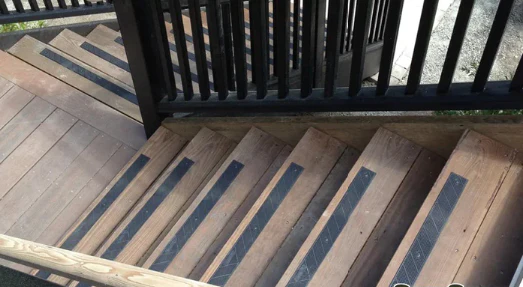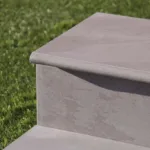Outdoor non slip stair treads for wooden steps are one of those home updates that often go unnoticed until they become a necessity. If you have ever hurried down damp porch stairs after a rainfall, or carefully made your way to the garden when snow had dusted everything in sight, you likely understand just how slippery wooden steps can get. Adding reliable traction that both improves safety and keeps the steps looking attractive is not just for peace of mind but also for genuine day-to-day convenience.
Staircases, especially outdoor wooden ones, experience a constant battle against weather exposure and wear. Rain, snow, dirt, and prolonged sunlight exposure all contribute to their quick deterioration and increased risk of slips and falls. By installing outdoor non slip stair treads, you not only protect your family, friends, and guests but also extend the lifespan of your wooden steps. For many homeowners, this small change creates a noticeable improvement in both safety and comfort.
Why Outdoor Non Slip Stair Treads Matter
Slips and falls are one of the most common household hazards, and outdoor stairs are a prime spot for accidents. Wood, by its natural composition, becomes slick when exposed to moisture. Even a fine mist covering a set of wood steps can drastically change their surface friction. Outdoor non slip stair treads provide texture and grip, ensuring a person’s footing remains steady regardless of footwear or conditions.
Choosing non slip stair treads outdoor is not just about adding traction. It is about preserving the beauty of your home’s exterior while still creating a welcoming, safe entryway for everyone who approaches. Wooden steps in particular highlight warmth and charm, but without additional safety measures, they turn into a liability during rainy or wintry seasons.
Types of Non Slip Stair Treads for Wooden Steps
Different types of outdoor non slip stair treads exist, and the best choice depends on your priorities: durability, design, ease of maintenance, or seasonal resistance. Wooden stairs are versatile, so you will find multiple material choices that complement natural finishes or painted styles.
Rubber Stair Treads
Rubber is one of the most popular choices for outdoor use because it holds up well under all weather conditions. It provides excellent grip, even when wet, and is available in various patterns that add both safety and style. Rubber outdoor treads often feature open-worked surfaces to allow water drainage, reducing pooling and ice formation. Learn more about the qualities of outdoor rubber stair treads for situations where extreme weather is common.
Carpet-Style Treads
Outdoor-grade carpet stair treads bring a homey feeling to a porch or deck. These types are treated with weather-resistant materials to prevent mold and fading. They feel softer underfoot compared to rubber or metal options and add a decorative look. However, they require regular cleaning to ensure dirt and moisture do not compromise them over time.
Adhesive Grip Strips
Adhesive strips, often made from textured grit or heavy-duty vinyl, provide a fast installation option. They adhere directly onto the wooden step surface, creating a gritty traction layer. While they require occasional replacement, they are affordable and effective for homeowners who want a no-fuss solution. These are especially handy for quickly making a slippery wood staircase safer without altering its design too much.
Metal And Aluminum Treads
For those prioritizing durability, metal stair treads are hard to rival. These come with grooved or perforated designs that grip shoes firmly. Their industrial appearance does not appeal to everyone, but for backyards, utility stairs, or entryways with frequent heavy foot traffic, they are among the most robust solutions.
Vinyl Treads
Vinyl treads stand in the middle of affordability and long-term reliability. Their weather-resistant nature makes them useful for homeowners who live in areas with varying climate conditions. They come in different surface textures and patterns to balance appearance and practicality. A good resource on this style is vinyl stair treads if you want to explore an option that prioritizes durability with budget-friendliness.
Benefits of Non Slip Stair Treads on Wooden Steps
The right stair tread choice brings multiple advantages beyond simple traction.
- Safety for everyone in the household: Whether young children darting to the yard or elderly family members needing stable footing, treads create an even, secure surface.
- Weather resilience: Wooden steps wear down quickly when water or snow lingers. Treads protect the wood itself and prevent faster deterioration.
- Cost-effective maintenance: Rather than sanding, staining, or sealing wood frequently, stair treads decrease exposure to harsh conditions, lowering upkeep costs.
- Visual appeal: Many modern treads complement wooden architecture instead of hiding it. Designs range from classic to contemporary, allowing homeowners to match their home’s style.
- Extended lifespan of steps: By shielding against scratches and fading caused by daily traffic, stair treads extend the functional life of the stairs themselves.
Installing Outdoor Non Slip Stair Treads
While professional installation is always an option, many stair treads are designed with homeowners in mind. The process often depends on the type of tread.
- Rubber and carpeted treads: These usually require adhesive backing or pre-drilled holes with screws to secure them in place.
- Adhesive strips: Simply peel off backing and press down onto cleaned, dry wood surfaces. They should be lined up neatly to minimize gaps.
- Metal treads: Proper fastening with durable screws or brackets ensures stability. These installations are more permanent and require precision.
- Vinyl treads: Typically installed with adhesive, though some heavy-duty versions can also use screws for reinforcement.
Regardless of type, preparation is key. Clean the wooden steps thoroughly to remove dust, moisture, and oils, then allow them to dry completely before installing the treads. This makes sure they adhere properly and wear evenly.
Maintenance and Care for Non Slip Stair Treads
Even though stair treads are designed to withstand heavy use and weather, regular upkeep helps them function optimally.
- Routine Cleaning: Sweep debris such as leaves or dirt, which can reduce traction if left on the surface.
- Seasonal Checks: Inspect for any lifting edges, cracks, or worn textures at the beginning of each season. Replace if necessary.
- Deep Cleaning: Rubber and vinyl treads can be washed with mild soap and water, while carpet treads benefit from occasional hose rinses.
- Snow and Ice Removal: For winter climates, use pet-safe salt or sand. Avoid harsh chemicals that might erode treads or stain wood.
Choosing the Right Design for Wooden Steps
Aesthetics matter, especially on a home’s main entryway. The right outdoor non slip stair treads should complement your home’s architectural style and color scheme. For example, rustic natural wood porches look beautiful with earthy-tone carpet-style treads, while sleek modern homes benefit from minimalistic rubber or vinyl designs with subtle textures.
If your wooden steps are part of a traditional staircase inside or outside the house, you may also consider reading more about stair treads in general to understand the variety of styles that seamlessly integrate with different decors.
Common Mistakes to Avoid
- Ignoring the type of wood: Different woods absorb moisture at different rates. Some treads may not adhere well without sealing your steps first.
- Poor alignment: Misaligned treads not only look uneven but can cause tripping hazards.
- Choosing style over function: Always prioritize slip resistance over aesthetics. A beautiful carpet tread is no good if it fails on a rainy day.
- Overlooking drainage: Water collection under treads leads to faster wood rotting. Select designs that encourage proper drainage.
Practical Tips From Experience
Living in an area where snow and rain alternate frequently through the seasons, I realized the importance of switching solutions when necessary. For summer and fall, adhesive strips worked fine because the steps stayed mostly dry. However, once winter arrived, thick rubber treads provided more grip and held up under shoveling. This flexibility showed me that sometimes homeowners benefit from adjusting their stair tread solutions throughout the year instead of relying on only one type permanently.
Another personal trick is to choose darker tones for outdoor treads. Lighter fabrics and finishes show dirt quickly, which leads to more cleaning. Darker shades keep the entryway looking crisp longer, even with daily foot traffic.
Conclusion
Outdoor non slip stair treads for wooden steps make a practical improvement that greatly increases safety without diminishing the beauty of your porch or deck. Wooden steps may radiate charm, but their vulnerability to weather and slipperiness makes them a prime candidate for accidents. By adding durable non slip stair treads outdoor, you protect your family, friends, and visitors while also extending the integrity of your stairs. With the variety of options available, from rubber and vinyl to carpet or adhesive styles, every homeowner can find a solution that matches their budget, climate, and design preferences.
Prioritizing safety does not mean sacrificing beauty. The right stair treads for wooden steps add both traction and character, blending seamlessly into the inviting look of your home. Investing in these simple additions ensures that your home entryway remains welcoming, functional, and most importantly, safe for every season of the year.



